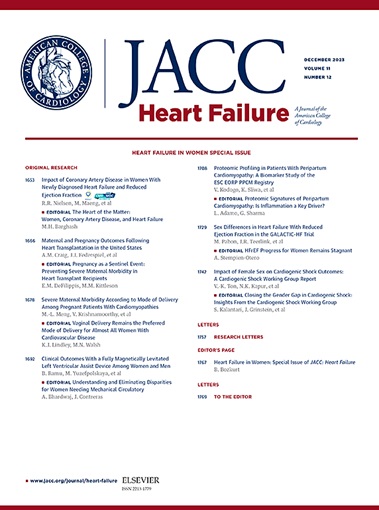萨库比特利/缬沙坦治疗心力衰竭且 eGFR 下降至 2.0 的患者
IF 10.3
1区 医学
Q1 CARDIAC & CARDIOVASCULAR SYSTEMS
引用次数: 0
摘要
背景介绍沙库比特利/缬沙坦是心力衰竭患者的基础治疗药物。尽管目前美国食品和药物管理局的标签并未就肾功能恶化患者开始或继续使用沙库比特利/缬沙坦提供指导,但指南将估计肾小球滤过率(eGFR)2列为治疗禁忌症:本研究旨在评估肾功能恶化、eGFR 低于 30 mL/min/1.73 m2 的患者继续服用沙库比妥/缬沙坦的安全性和有效性:在对PARADIGM-HF和PARAGON-HF进行的一项事后平行试验分析中,使用时间更新的Cox模型评估了eGFR 2恶化、疗效和安全性结果与使用沙库比特利/缬沙坦与肾素-血管紧张素系统抑制剂治疗之间的关系:在 PARADIGM-HF 的 8346 名随机患者和 PARAGON-HF 的 4746 名随机患者中,分别有 691 人(8.3%)和 613 人(12.9%)在随访期间至少一次出现 eGFR 2。在 PARADIGM-HF 和 PARAGON-HF 中,出现这种恶化的患者发生主要结局的风险较高。然而,在PARADIGM-HF(Pinteraction = 0.50)和PARAGON-HF(Pinteraction = 0.64)中,无论肾功能是否恶化,使用沙库比曲/缬沙坦与肾素-血管紧张素系统抑制剂相比,主要结局的发生率仍然较低。eGFR 恶化患者的主要安全性结果发生率较高;然而,各治疗组之间的发生率相似,包括仍在接受治疗的患者:结论:肾功能恶化至eGFR 30 mL/min/1.73 m2以下的患者面临心血管和肾脏疾病结局的高风险。继续服用沙库比特利/缬沙坦可带来持续的临床获益,且不会增加安全性风险。这些数据支持在 eGFR 下降到这一阈值以下时继续使用沙库比特利/缬沙坦治疗心衰(PARADIGM-HF [前瞻性比较 ARNI 与 ACEI 以确定对心衰患者总体死亡率和发病率的影响],NCT01035255;以及 PARAGON-HF [前瞻性比较 ARNI 与 ARB 对射血分数保留的心衰患者的总体疗效],NCT01920711)。本文章由计算机程序翻译,如有差异,请以英文原文为准。
Sacubitril/Valsartan in Patients With Heart Failure and Deterioration in eGFR to <30 mL/min/1.73 m2
Background
Sacubitril/valsartan is a foundational therapy for patients with heart failure. Although current U.S. Food and Drug Administration labeling does not provide guidance regarding initiation or continuation of sacubitril/valsartan in patients with worsening kidney function, guidelines identify estimated glomerular filtration rate (eGFR) <30 mL/min/1.73 m2 as a contraindication to therapy.
Objectives
This study aims to assess the safety and efficacy of continuing sacubitril/valsartan in patients with deterioration of kidney function below an eGFR of 30 mL/min/1.73 m2.
Methods
The association between a deterioration in eGFR <30 mL/min/1.73 m2, efficacy and safety outcomes, and treatment with sacubitril/valsartan vs renin-angiotensin system inhibitor were evaluated using time updated Cox models in a post hoc parallel trial analyses of PARADIGM-HF and PARAGON-HF.
Results
Among 8,346 randomized patients in PARADIGM-HF and 4,746 in PARAGON-HF, 691 (8.3%) and 613 (12.9%), respectively, had an eGFR <30 mL/min/1.73 m2 at least once in follow-up. Patients experiencing such deterioration were at higher risk of the primary outcome in both PARADIGM-HF and PARAGON-HF. However, the incidence of the primary outcome remained lower with sacubitril/valsartan vs renin-angiotensin system inhibitor, regardless of deterioration in kidney function in both PARADIGM-HF (Pinteraction = 0.50) and PARAGON-HF (Pinteraction = 0.64). Rates of key safety outcomes were higher among patients experiencing eGFR deterioration; however, rates were similar between treatment groups including among those who remained on treatment.
Conclusions
Patients experiencing deterioration of kidney function to a value below eGFR 30 mL/min/1.73 m2 faced high risk of cardiovascular and kidney disease outcomes. Continuation of sacubitril/valsartan was associated with persistent clinical benefit and no incremental safety risk. These data support continuation of sacubitril/valsartan for heart failure treatment even when eGFR declines below this threshold (PARADIGM-HF [Prospective Comparison of ARNI with ACEI to Determine Impact on Global Mortality and Morbidity in Heart Failure], NCT01035255; and PARAGON-HF [Prospective Comparison of ARNI with ARB Global Outcomes in HF with Preserved Ejection Fraction], NCT01920711)
求助全文
通过发布文献求助,成功后即可免费获取论文全文。
去求助
来源期刊

JACC. Heart failure
CARDIAC & CARDIOVASCULAR SYSTEMS-
CiteScore
21.20
自引率
2.30%
发文量
164
期刊介绍:
JACC: Heart Failure publishes crucial findings on the pathophysiology, diagnosis, treatment, and care of heart failure patients. The goal is to enhance understanding through timely scientific communication on disease, clinical trials, outcomes, and therapeutic advances. The Journal fosters interdisciplinary connections with neuroscience, pulmonary medicine, nephrology, electrophysiology, and surgery related to heart failure. It also covers articles on pharmacogenetics, biomarkers, and metabolomics.
 求助内容:
求助内容: 应助结果提醒方式:
应助结果提醒方式:


